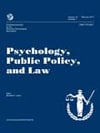Knowledge of a confession may alter the willingness to corroborate alibi even among friends. This is the bottom line of a recently published article in Psychology, Public Policy, and Law. Below is a summary of the research and findings as well as a translation of this research into practice.

Featured Article | Psychology, Public Policy, and Law | 2018, Vol. 24, No. 3, 353–364
A novel paradigm for examining alibi corroboration and evidence interaction: Does a confession affect the likelihood of alibi corroboration for friends and strangers?
Authors
Megan R. Kienzle, University of Florida
Lora M. Levett, University of Florida
Abstract
We examined the possibility that hearing about a confession could influence potentially exonerating information proffered by a familiar or unfamiliar alibi corroborator. College students (N = 268) brought a friend to a team building session. After the team building session, we asked participants to corroborate an alibi for either their friend or a stranger accused of theft. We also manipulated whether the suspect confessed and the timing of when the confession information was presented to participants. Friends were more likely than strangers to be alibi corroborators across multiple scales and dependent measures. Further, potential corroborators who heard about the suspect’s confession were less likely than those who did not know of the confession to be willing to serve as an alibi corroborator; hearing about a suspect’s confession after making an initial alibi corroboration caused participants to change their decisions. Qualitative analyses also suggest several possible motivations given by corroborators and noncorroborators. Implications for police procedure and research design are discussed.
Keywords
alibi generation, evidence interaction, evidence contamination, forensic confirmation bias
Summary of the Research
“In 1986, John Kogut was wrongfully convicted of the rape and murder of a 16-year-old girl. During the investigation of these crimes, Kogut was subjected to an 18-hr interrogation, at the end of which he falsely confessed; he later recanted the confession. During the time of the crime, Kogut was actually at his girlfriend’s birthday party, and therefore theoretically should have had multiple alibi corroborators in the other people present at the party who could help to prove his innocence. Many of these individuals were willing to corroborate his story initially, but none testified in court. It is possible that hearing about Kogut’s confession caused the potential alibi corroborators to question their memory and ultimately withdraw their original statements. Thus, one piece of erroneous evidence (the false confession) may have corrupted potentially exculpatory evidence (the alibi corroborations). This paper explores that possibility, introduces a new paradigm for studying alibi corroboration, and addresses whether confession evidence can corrupt potentially exonerating evidence given by friend versus stranger alibi corroborators.” (p. 353)
“Basic psychological research supports the idea that pieces of evidence have potential to change other evidence through confirmation biases. Kassin and colleagues termed this forensic confirmation bias, or the idea that an individual’s beliefs, motivations, expectations, or situational context can influence their interpretation of other evidence in a criminal trial. Specifically, if investigators espouse beliefs about the suspect’s guilt or are given contextual information, those beliefs can affect their interpretation of subsequent evidence. […] knowledge of contextual information essentially focuses the investigation or trial on the inculpatory evidence, strengthening inculpatory evidence through affecting the focus on and interpretation of subsequent evidence.” (p. 353)
“Forensic confirmation bias has been demonstrated in decisions of fingerprint examiners, handwriting analysis, polygraph interpreters, DNA analysts, eyewitnesses, participants examining facial composites, crime scene investigation, and participants examining speech recordings—anywhere a human factors into the forensic decision making process. Further, the advent of rapid identification information technology provides investigators with on-the scene database matches which can impact the interpretation of relevant crime scene information from the moment the match is made and increase the importance assigned to that piece of evidence. The collective literature demonstrates the pervasiveness of the forensic confirmation bias, reaching from analysis of evidence in a field or laboratory setting to the memory based forms of evidence. Every stage of the investigation and evidence collection process, through the trial, can be impacted by prior knowledge or contextual information. […] Investigators are generally aware of the problematic influence that confirmation biases may have in their decisions. However, common recommendations to move to the other end of the spectrum where investigators are completely blind to all external context has problems as well.” (p. 353–354)
“Forensic confirmation bias seems to be most influential in cases where the evidence itself is somewhat ambiguous. […] There is also some evidence to support that the order in which evidence is perceived affects whether forensic confirmation bias will occur. […] Research has shown that forensic confirmation bias may be especially strong in an investigation in which the corrupting evidence provided is a confession. Learning of a confession may change the decisions of legal actors during the investigation.” (p. 354)
“The same confirmation biases that affect legal actors during investigation also appear to affect juries. Confessions influence jury verdicts, and this effect is persistent under less than ideal confession conditions. Jurors believe the likelihood of a false confession is low even with coercion, and confessions influence verdict even if the jurors believe the confession was coerced or obtained through a secondary source who may be motivated to lie. Exacerbating the problem, juries may hear other pieces of evidence that have been corrupted by the confession and more indicative of guilt. […] Further, research supports the idea that jurors may evaluate the confession evidence to be voluntary depending (1) on the strength of the rest of the case evidence and (2) on their chosen verdict, even after the fact” (p. 354)
“The problem of confessions corrupting other pieces of evidence through forensic confirmation biases becomes particularly problematic when the evidence corrupted is memory evidence. That is, if forensic confirmation biases affect physical evidence, it may be possible to retest the evidence under bias-free conditions (e.g., a fingerprint examiner who is blind to expected outcomes or contextual information could reexamine the fingerprint). However, in the case of memory evidence, the contextual information may permanently change the evidence. This is even more troublesome if the memory evidence is potentially exonerating.” (p. 355)
“A confession may affect an eyewitness’s or alibi corroborator’s memory through forensic confirmation bias. […] learning of a confession can not only affect other pieces of incriminating evidence, suggesting that sometimes weak evidence may be present in the courtroom, but also may contribute to keeping good (and potentially exculpatory) evidence out of the courtroom. In Kogut’s case, his false confession likely corrupted exonerating information from his potential alibi corroborators. In this study, we test this possibility that potential friend and stranger alibi corroborators are subject to the same cognitive confirmation biases as eyewitnesses, fingerprint examiners, police investigators, and judges and jurors when they hear about a suspect’s confession, expanding previous work examining forensic confirmation bias in alibi corroboration to include different types of alibi corroborators.” (p. 355)
“Research suggests that the relationship between the person and defendant may matter in whether a person will corroborate an alibi. Familiar alibi corroborators are less likely than nonfamiliar corroborators to be mistaken in their corroboration because the identity of the suspect is not in question. However, using experimentally induced friend relationships, researchers found that friends and strangers were equally likely to provide an alibi and instead, alibi corroborators based their decisions of whether to corroborate the alibi or not on the evidence present to suggest guilt. We expanded on that literature to examine alibi corroboration in preexisting friendships instead of experimentally induced friendships, hypothesizing that alibi corroborators who are true friends would be more likely than strangers to proffer an alibi corroboration, and that friends may be less subject to forensic confirmation biases than alibi corroborators who are unfamiliar with the suspect (i.e., strangers).” (p. 355)
“To address our research question, we created a new paradigm for examining person alibi corroboration through a false theft accusation. In this study, we recruited participants under the guise of participating in a team building activity over two sessions. All participants were required to bring a friend to the first team building session. In this session, participants and friends completed a variety of team-building activities, switching between new ‘teams’ in every activity. In the second session, participants were told individually that either their friend or a stranger was accused of a theft that took place during the first session, however in reality the theft never occurred. We varied whether participants were made aware of the suspect’s confession to the crime (and the timing of the presentation of that evidence). Participants were asked to provide an alibi corroboration for the suspect. The alleged crime never took place, so we explicitly were asking for a false alibi corroboration of a nonexistent crime. However, these variables were constant across conditions, allowing us to isolate the effects of the relationship between the alibi corroborator and the suspect and the confession information on alibi corroborator decision making.” (p. 355)
Participants included 268 students aged 17 to 32 (M = 24.62), 66% female, 34% male, mostly White (51%).
“Contrary to previous research that found friends and strangers were equally likely to provide an alibi corroboration, in this study, friends were more likely than strangers to be alibi corroborators, to be confident in that corroboration, believe the confession was coerced, and overall believe the suspect was (correctly) innocent. Friends also said they believed they had better memories and viewing conditions for the suspect’s actions than strangers (although they were less likely than strangers to cite their memories as a reason for proffering a corroboration). Thus, it appears that the relationship between the alibi corroborator and suspect affects whether a participant will corroborate a suspect’s alibi. It is possible that the reluctance of strangers to serve as an alibi corroborator could be understood through the lens of a bystander effect.” (p. 361)
“The idea that strangers may be less willing to serve as alibi corroborators than friends is troubling, especially given that jurors are more likely to believe alibi corroborators with no relationship to the suspect than those with a relationship. That is, the most believable alibi corroborator (the stranger) is not the most probable one (the friend). Consistent with jurors’ concerns, however, friends were more likely than strangers to cite reasons other than their memory (i.e., the person’s character or lack of motive to steal) in their justifications of the decision to be an alibi corroborator even though friends rated their memories and view for the time frame as higher.” (p. 361)
“It appears that friends and strangers may be equally susceptible to confirmation biases through the corruptive power of a confession. That is, familiarity with the suspect did not differentially affect willingness to provide an alibi corroboration in the confession conditions. Even though friends were more likely than strangers to believe the confession was coerced, friends and strangers were equally likely to change their corroboration decision after hearing about a confession, and friends were more likely than strangers to cite the confession as a justification for not serving as an alibi. It is possible that more power would be needed to detect this interaction; future research could explore this possibility. It is also possible that this is demonstrative of the power of the confession—the presence of a confession affected decision making regardless of the relationship between the alibi corroborator and suspect.” (pp. 361–362)
“The present study demonstrates that confessions can corrupt potentially exonerating evidence, even if that potentially exonerating evidence is an alibi corroboration from a friend. Thus, it appears that forensic confirmation bias can alter person evidence, as seen here with alibi corroborators and in previous research examining eyewitness decision making.” (p. 362)
“Unlike other forms of evidence, the potentially exonerating evidence of an alibi corroboration is likely discarded if the suspect’s alibi is not corroborated because of forensic confirmation biases. Thus, we have no way of knowing how many cases are missing potential alibi corroborators who could have helped to prove an innocent suspect’s case. In addition, while forensic experts and fingerprint analysts have the original evidence preserved to retest if necessary, person evidence given by alibi corroborators is forever changed by the knowledge of a confession; one cannot simply start over once this information has been revealed.” (p. 362)
Translating Research into Practice
“It may be premature to recommend change in the collection of information from alibi corroborators given this is a relatively new area of research. However, many recommendations have been put forth to attempt to correct for or protect against forensic confirmation biases in the legal context. […] [Forensic] analysts are not the only legal actors who need to focus on documentation to ensure the ability to (a) detect if contamination has occurred; (b) where the contamination came from; and (c) in cases where retesting is not an option, accurately describe the contamination effects to judges and jurors so they can appropriately account for the quality of evidence in determining whether it meets admissibility standards, or how to weigh it in combination with all other evidence in judging guilt or innocence. This study, as well as the others cited previously, suggest that it may be pertinent for investigators to use similar documentation and methods to preserve how an alibi corroboration is obtained and considered. Further, given that is it possible for alibi corroborators to be affected by contextual information, investigators should protect alibi corroborators from potentially corruptive information whenever possible.” (p. 363)
Other Interesting Tidbits for Researchers and Clinicians
“One limitation of this study is that all participants were innocent suspects. Thus, we were unable to determine whether participants were equally likely to corroborate a guilty suspect or innocent suspect’s alibi. Future research could examine this possibility, and examine the corruptibility of a known or unknown false alibi corroboration.” (p. 362)
“Another limitation of this work is that no crime actually took place, so there was no real need for an alibi corroboration. In that sense, all of the alibi corroborations were ‘false’ because they were false corroborations of a nonexistent crime. In addition, another limitation of the paradigm is the nature of the activity itself. Recall that during the team building session, it was difficult for participants to track the behavior of the others in the room. Therefore, it is possible that we may have created a situation in which we were the most likely to see an effect of the relationship between the alibi corroborator and suspect on alibi corroboration.” (p. 362)
“Further, it is possible that the familiarity manipulation we used in this study affected outcomes. For example, it is conceivable that the alibi corroborator felt a strong sense of responsibility for the friend because he or she brought the friend to the session, and this may have affected his or her decision making. A similar sense of responsibility may not exist in more realistic situations involving a familiar alibi corroborator. Further, it is impossible to know whether friends brought to the session actually shared study information with participants. Future research could attempt to correct these possibilities by altering the paradigm.” (pp. 362–363)
“Another limitation of this paradigm is that the theft represents a minor crime, and unlikely to advance to the stage of a criminal prosecution. It is possible that a more realistic, ecologically valid scenario might alter the results presented here. This simulated, false theft scenario may be limited in the ability to generalize to the many other types of alibi corroborations that are sought in investigation of crime. Additional research may want to examine the possibility that severity of the alleged offense may moderate the relationship effect on alibi corroboration decisions.” (p. 363)
“Further, while anecdotal information from the experimenter suggests that participants in the second session believed that someone was accused of a theft, it is possible participants may have not believed the experiment was real. That would limit the ability to capture participants’ real responses. Last, we were unable to capture the nonmotivated familiar other alibi corroborator in this paradigm. Future research could attempt to better capture this relationship in examining alibi corroboration.” (p. 363)
Join the Discussion
As always, please join the discussion below if you have thoughts or comments to add!






















